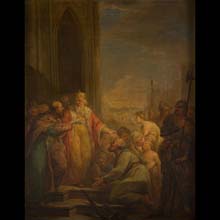
material: oil on canvas
dimensions: 66,5 x 52 cm
description: There was an inscription above this painting in the room in the Warsaw castle reading: LEGES CASIMIRI MAGNI. A. MCCCXLVII (“The laws of Casimir the Great, the year 1347”). The king did not order any specific historical figures to be depicted in this canvas, and he referred to the dignitaries surrounding King Casimir only as “Ministres” [Ministers]. Casimir the Great, portrayed in front of the castle portal, is addressing a royal courtier, who is holding a book with the inscription: Statuta Casimiri Regis (“Statutes of Casimir the Great”). With his hand the king is pointing at peasants, surrounded by knights, kneeling before him. A knight in armour is holding a shield bearing the White Eagle and the Lion – probably the inaccurately depicted coat of arms of Ruthenia. The combination of the two coats of arms is an allusion to the incorporation of the Halych Ruthenia into the Crown of the Kingdom of Poland after 1340. In the background, one can see the castle under construction, covered by scaffoldings. Representatives of the Enlightenment, working on the reformation of the Polish legislation in the 18th century, emphasized the significance of the codification of laws made by Casimir the Great in Wiślica in 1347. The painting illustrates this and other achievements of the king that were eulogized by the Polish historiographers, Długosz and Naruszewicz: the taking care of peasants, who Casimir, called the “king of peasants,” defended against the lawlessness of magnates and the erection of stone buildings in medieval Poland (in accordance with the saying that Casimir “came to a Poland of wood, and left a Poland of stone”). Barbara Ciciora
exposition: The Gallery of 19th Century Polish Art in Sukiennice,
The Cloth Hall, 1, Main Market Square
key: Enlightenment >>>
dimensions: 66,5 x 52 cm
description: There was an inscription above this painting in the room in the Warsaw castle reading: LEGES CASIMIRI MAGNI. A. MCCCXLVII (“The laws of Casimir the Great, the year 1347”). The king did not order any specific historical figures to be depicted in this canvas, and he referred to the dignitaries surrounding King Casimir only as “Ministres” [Ministers]. Casimir the Great, portrayed in front of the castle portal, is addressing a royal courtier, who is holding a book with the inscription: Statuta Casimiri Regis (“Statutes of Casimir the Great”). With his hand the king is pointing at peasants, surrounded by knights, kneeling before him. A knight in armour is holding a shield bearing the White Eagle and the Lion – probably the inaccurately depicted coat of arms of Ruthenia. The combination of the two coats of arms is an allusion to the incorporation of the Halych Ruthenia into the Crown of the Kingdom of Poland after 1340. In the background, one can see the castle under construction, covered by scaffoldings. Representatives of the Enlightenment, working on the reformation of the Polish legislation in the 18th century, emphasized the significance of the codification of laws made by Casimir the Great in Wiślica in 1347. The painting illustrates this and other achievements of the king that were eulogized by the Polish historiographers, Długosz and Naruszewicz: the taking care of peasants, who Casimir, called the “king of peasants,” defended against the lawlessness of magnates and the erection of stone buildings in medieval Poland (in accordance with the saying that Casimir “came to a Poland of wood, and left a Poland of stone”). Barbara Ciciora
exposition: The Gallery of 19th Century Polish Art in Sukiennice,
The Cloth Hall, 1, Main Market Square
key: Enlightenment >>>












